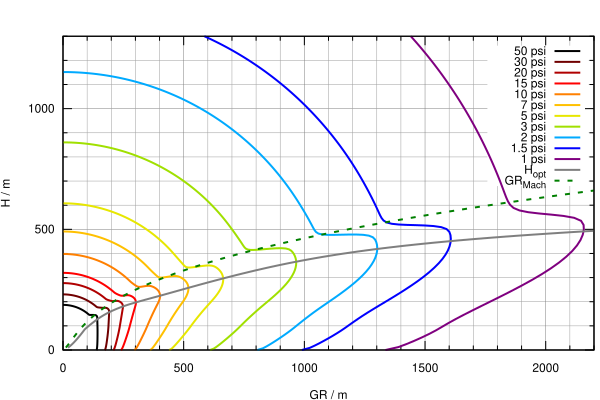File:Blastcurves psi.svg

Original file (SVG file, nominally 600 × 400 pixels, file size: 73 KB)
Captions
Captions
Summary[edit]
| DescriptionBlastcurves psi.svg |
English: Overpressure ranges from 1 to 50 psi (6.9 to 345 kPa) of a 1 kiloton air burst as a function of burst height. The thin grey curve indicates the approximate optimum burst height for a given ground range.
Deutsch: Abhängigkeit des Druckpegels einer 1-Kilotonnen-Explosion von Entfernung und Detonationshöhe. Die dünne graue Kurve gibt näherungsweise die optimale Detonationshöhe an. |
| Date | Created: 21 November 2008 |
| Source | Own work |
| Author | SiriusB |
| Other versions | Image:Blastcurves_1.png |
Additional Info[edit]
Plotted with Gnuplot 4.2.2. Isobars are based on numerically solved formulae from the internal help pages of the BLAST software, the H_opt curve is an analytical fit using the inversely plotted formula
This function should fit both BLAST output and Figures 3.73a-c taken from Glasstone, Dolan, The Effects of Nuclear Weapons, 1977 (EoNW77) as a compromise. Both sources differ slightly. EoNW77 shows the maximum low-pressure ranges at somewhat lower altitudes whereas for high pressures >40 psi BLAST shows no optimum altitudes at all (see the innermost isobar). However, since numerical fitting of curves taken from a paper would be a Sisyphean task while BLAST already outputs plottable numbers, only isobars from the latter are plotted here.
A note on the new version on June 6 2022: The interpolation between the Mach zone and the regular reflection zone has been altered in order to steepen the "knees". This provides a better fit to the Figures 3.73a-c in EoNW77 where the relation of GR to H is actually not unique but features local minima at the onsets of the "knees" for intermediate overpressures. In addition, contours for 1.5, 7 and 15 psi have been added.
Why psi?[edit]
Most sources, e.g. Glasstone & Dolan (1977) or Carey Sublette's Nuclear Weapon Archive use pounds per square inch as pressure units. As a rule of the thumb, e.g. most non-reinforced buildings are destroyed for overpressures above 5 psi. However, the pressures can easily be converted into SI units, e.g. kilopascals, where 1 psi = 6.8947573 kPa or, roughly, one psi equals seven kPa.
Additional notes[edit]
A note on Gnuplot SVG terminal: Set size variable as "fixed" (the default in Gnuplot), not "dynamic", to ensure correct aspect ratio. This was the reason for uploading a 2nd version.
Licensing[edit]
| Public domainPublic domainfalsefalse |
| I, the copyright holder of this work, release this work into the public domain. This applies worldwide. In some countries this may not be legally possible; if so: I grant anyone the right to use this work for any purpose, without any conditions, unless such conditions are required by law. |
File history
Click on a date/time to view the file as it appeared at that time.
| Date/Time | Thumbnail | Dimensions | User | Comment | |
|---|---|---|---|---|---|
| current | 13:46, 6 June 2022 |  | 600 × 400 (73 KB) | SiriusB (talk | contribs) | Modification of the Mach-to-Regular reflection zone interpolation.This steepens the |
| 10:46, 21 November 2008 |  | 600 × 400 (75 KB) | SiriusB (talk | contribs) | {{Information |Description= |Source= |Date= |Author= |Permission= |other_versions= }} | |
| 10:40, 21 November 2008 |  | 512 × 341 (75 KB) | SiriusB (talk | contribs) | {{Information |Description={{en|1=Overpressure ranges from 1 to 50 psi (6.9 to 345 kPa) of a 1 kiloton air burst as a function of burst height. The thin grey curve indicates the approximate optimum burst height for a given ground range.}} {{de|1=Abhängig |
You cannot overwrite this file.
File usage on Commons
The following page uses this file:
File usage on other wikis
The following other wikis use this file:
- Usage on de.wikipedia.org
- Usage on en.wikipedia.org
- Usage on it.wikipedia.org
- Usage on ms.wikipedia.org
Metadata
This file contains additional information such as Exif metadata which may have been added by the digital camera, scanner, or software program used to create or digitize it. If the file has been modified from its original state, some details such as the timestamp may not fully reflect those of the original file. The timestamp is only as accurate as the clock in the camera, and it may be completely wrong.
| Short title | Gnuplot |
|---|---|
| Image title | Produced by GNUPLOT 5.4 patchlevel 3 |
| Width | 600 |
| Height | 400 |
